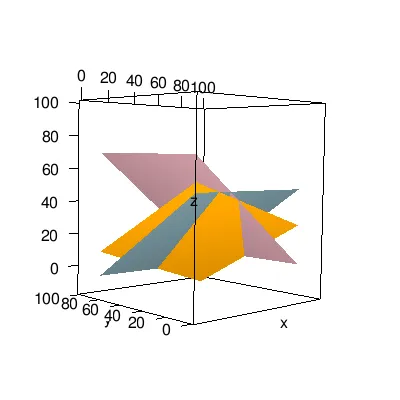我想绘制一个由以下不等式描述的多面体:
3*x+5*y+9*z<=500
4*x+5*z<=350
2*y+3*z<=150
x,y,z>=0
这是一个线性规划问题。其目标函数为:
4*x+3*y+6*z
这个程序的可行区域是一个多面体。 我可以将不等式绘制为平面,这应该可以描述多面体。 (请注意,这是我第一次尝试使用rgl,所以代码有点乱。如果您想改进它,请随意这样做):
# setup
x <- seq(0,9,length=20)*seq(0,9,length=20)
y <- x
t <- x
f1 <- function(x,y){y=70-0.8*x}
z1 <- outer(x,y,f1)
f2 <- function(x,y){500/9-x/3-(5*y)/9}
z2 <- outer(x,y,f2)
f3 <- function(x,y){t=50-(2*y)/3}
z3 <- outer(x,y,f3)
# plot planes with rgl
uM = matrix(c(0.72428817, 0.03278469, -0.68134511, 0,
-0.6786808, 0.0555667, -0.7267077, 0,
0.01567543, 0.99948466, 0.05903265, 0,
0, 0, 0, 1),
4, 4)
library(rgl)
open3d(userMatrix = uM, windowRect = c(0, 0, 400, 400))
rgl.pop("lights")
light3d(diffuse='white',theta=0,phi=20)
light3d(diffuse="gray10", specular="gray25")
rgl.light(theta = 0, phi = 0, viewpoint.rel = TRUE, ambient = "#FFFFFF",
diffuse = "#FFFFFF", specular = "#FFFFFF", x=30, y=30, z=40)
rgl.light(theta = 0, phi = 0, viewpoint.rel = TRUE, ambient = "#FFFFFF",
diffuse = "#FFFFFF", specular = "#FFFFFF", x=0, y=0, z=0)
bg3d("white")
material3d(col="white")
persp3d(x,y,z3,
xlim=c(0,100), ylim=c(0,100), zlim=c(0,100),
xlab='x', ylab='y', zlab='z',
col='lightblue',
ltheta=100, shade=0, ticktype = "simple")
surface3d(x, y, z2, col='orange', alpha=1)
surface3d(t, y, z1, col='pink', alpha=1, smooth=TRUE)

现在我想绘制由这些平面描述的区域。
x,y,z>=0.
但我不知道该怎么做。我试着这样做:
x <- seq(0,9,length=20)*seq(0,9,length=20)
y <- x
z <- x
f4 <- function(x,y,t){
cond1 <- 3*x+5*y+9*z<=500
cond2 <- 4*x+5*z<=350
cond3 <- 2*y+3*z<=150
ifelse(cond1, 3*x+5*y+9*z,
ifelse(cond2, 4*x+5*z,
ifelse(cond3, 2*y+3*z,0)))
}
f4(x,y,z)
z4 <- outer(x,y,z,f4) # ERROR
但是这就是我卡住的地方。outer()仅为2个变量定义,但我有三个。我该如何继续?

outer得到什么输出?你打算如何使用它——在调用surface3d时?请详细说明。 - krlmlr